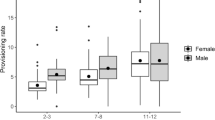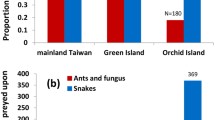Abstract
When parental care is costly, parents should avoid caring for unrelated young. Therefore, it is an advantage to discriminate between related and unrelated offspring so that parents can make informed decisions about parental care. In the present study, we test the hypothesis that male sand gobies (Pomatoschistus minutus) recognize and differentially care for their own offspring when given a choice between a nest with sired eggs and a second nest with eggs sired by an unrelated male. The sand goby is a species with exclusive and costly paternal care. Male parasitic spawnings (e.g., sneaking) as well as nest takeovers by other males are common. Our results show that nests containing sired eggs were preferred and received significantly more care, as measured by nest building and nest occupancy, than nests with foreign eggs even when males cared for both nests. These findings suggest that males respond to paternity cues and recognize their own clutches. Relative clutch size also had a significant effect on male parental care. When sired clutches were larger than foreign clutches, males preferred to care for their own nest. In the few cases where males chose to take care of foreign nests, the foreign clutch was larger than their own clutch. Taken together, our results provide evidence that both paternity cues and clutch size influence parenting decisions among male sand gobies.

Similar content being viewed by others
References
Arnold KE, Owens IPF (2002) Extra-pair paternity and egg dumping in birds: life history, parental care and the risk of retaliation. Proc R Soc Lond B 269:1263–1269
Bandoli JH (2002) Brood defense and filial cannibalism in the spottail darter (Etheostoma squamiceps): the effects of parental status and prior experience. Behav Ecol Sociobiol 51:222–226
Bandoli JH (2006) Male spottail darters (Etheostoma squamiceps) do not use chemical or positional cues to discriminate between sired and foster eggs. Behav Ecol Sociobiol 59:606–613
Beecher MD (1991) Success and failure of parent-offspring recognition in animals. In: Heppr PH (ed) Kin recognition. Cambridge University Press, Cambridge, pp 94–124
Brown GE, Brown JA (1996) Kin discrimination in salmonids. Rev Fish Biol Fish 6:201–219
Buczkowski G, Silverman J (2005) Context-dependent nestmate discrimination and the effect of action thresholds on exogenous cue recognition in the Argentine ant. Anim Behav 69:741–749
Clutton-Brock TH (1991) The evolution of parental care. Princeton University Press, Princeton
Evans TA (1998) Offspring recognition by mother crab spiders with extreme maternal care. Proc R Soc Lond B 265:129–134
Forsgren E (1997) Mate sampling in a population of sand gobies. Anim Behav 53:267–276
Forsgren E (1999) Sexual selection and sex roles in the sand goby. In: Almada VC, Oliveira RF, Gonçalves EJ (eds) Behaviour and conservation of littoral fishes. ISPA, Lisboa, pp 249–274
Forsgren E, Karlsson A, Kvarnemo C (1996) Female sand gobies gain direct benefits by choosing males with eggs in their nests. Behav Ecol Sociobiol 39:91–96
Frommen JG, Brendler C, Bakker TCM (2007) The tale of the bad stepfather: male three-spined sticklebacks Gasterosteus aculeatus L. recognize foreign eggs in their manipulated nest by egg cues alone. J Fish Biol 70:1295–1301
Gibbons ME, Ferguson AM, Lee DR, Jaeger RG (2003) Mother-offspring discrimination in the red-backed salamander may be context dependent. Herpetologica 59:322–333
Hain TJA, Neff BD (2006) Promiscuity drives self-referent kin recognition. Curr Biol 16:1807–1811
Hauber ME, Sherman PW (2001) Self-referent phenotype matching: theoretical considerations and empirical evidence. Trends Neurosci 24:609–616
Hauber ME, Moskat C, Ban M (2006) Experimental shift in hosts’ acceptance threshold of inaccurate-mimic brood parasite eggs. Biol Lett 2:177–180
Japyassu HF, Macagnan CR, Knysak I (2003) Eggsac recognition in Loxosceles gaucho (Araneae, Sicariidae) and the evolution of maternal care in spiders. J Arachnol 31:90–104
Jones JC, Reynolds JD (1999) The influence of oxygen stress on female choice for male nest structure in the common goby. Anim Behav 57:189–196
Jones AG, Walker D, Lindström K, Kvarnemo C, Avise JC (2001) Surprising similarity of sneaking rates and genetic mating patterns in two populations of the sand goby experiencing disparate sexual selection regimes. Mol Ecol 10:461–469
Kvarnemo C (1995) Size-assortative nest choice in the absence of competition in males of the sand goby, Pomatoschistus minutus. Environ Biol Fishes 43:233–239
Kvarnemo C, Svensson O, Forsgren E (1998) Parental behaviour in relation to food availability in the common goby. Anim Behav 56:1285–1290
Lazzaretto I, Salvato B (1992) Cannibalistic behavior in the harpacticoid copepod Tigriopus fulvus. Mar Biol 113:579–582
Lindström K (1998) Effects of costs and benefits of brood care on filial cannibalism in the sand goby. Behav Ecol Sociobiol 42:101–106
Lindström K, Ranta E (1992) Predation by birds affects population-structure in breeding sand goby, Pomatoschistus minutus, males. Oikos 64:527–532
Lindström K, Hellström M (1993) Male size and parental care in the sand goby, Pomatoschistus minutus. Ethol Ecol Evol 5:97–106
Lindström K, Pampoulie C (2005) Effect of resource holding potential and resource value on tenure at nest sites in sand gobies. Behav Ecol 16:70–74
Lissåker M, Kvarnemo C (2006) Ventilation or nest defense—parental care trade-offs in a fish with male care. Behav Ecol Sociobiol 60:864–873
Lissåker M, Svensson O (2008) Cannibalize or care? The role of perceived paternity in the sand goby, Pomatoschistus minutus. Behav Ecol Sociobiol 62:1467–1475
Lissåker M, Kvarnemo C, Svensson O (2003) Effects of a low oxygen environment on parental effort and filial cannibalism in the male sand goby, Pomatoschistus minutus. Behav Ecol 14:374–381
Loiselle P (1983) Filial cannibalism and egg recognition by males of primitive custodial teleost Cyprinodon macularius californiensis Girard (Ntherinomorpha: Cyprinodontidae). Ethol Sociobiol 4:1–9
Magnhagen C, Vestergaard K (1993) Brood size and offspring age affect risk-taking and aggression in nest-guarding common gobies. Behaviour 125:233–243
Main AR, Bull CM (1996) Mother-offspring recognition in two Australian lizards, Tiliqua rugosa and Egernia stokesii. Anim Behav 52:193–200
Malavasi S, Lindström K, Sundström L (2001) Behaviour and success of sneaker males in the sand goby, Pomatoschistus minutus. Acta Ethol 4:3–9
Manica A (2004) Parental fish change their cannibalistic behaviour in response to the cost-to-benefit ratio of parental care. Anim Behav 67:1015–1021
McKaye KR, Barlow G (1976) Chemical recognition of young by the midas cichlid, Cichlasoma citrinellum. Copeia 1976:276–282
Neff BD (2003a) Decisions about parental care in response to perceived paternity. Nature 422:716–719
Neff BD (2003b) Paternity and condition affect cannibalistic behavior in nest-tending bluegill sunfish. Behav Ecol Sociobiol 54:377–384
Neff BD, Gross MR (2001) Dynamic adjustment of parental care in response to perceived paternity. Proc R Soc Lond B 268:1559–1565
Neff BD, Sherman PW (2002) Decision making and recognition mechanisms. Proc R Soc Lond B 269:1435–1441
Olsson KH, Kvarnemo C, Svensson O (2009) Relative costs of courtship behaviours in nest-building sand gobies. Anim Behav 77:541–546
Östlund-Nilsson S (2002) Does paternity or paternal investment determine the level of paternal care and does female choice explain egg stealing in the fifteen-spined stickleback? Behav Ecol 13:188–192
Pfennig DW (1997) Kinship and cannibalism. Bioscience 47:667–675
Rios-Cardenas O, Webster AS (2005) Paternity and paternal effort in the pumpkinseed sunfish. Behav Ecol 16:914–921
Sheldon BC (2002) Relating paternity to paternal care. Phil Trans R Soc Lond B 357:341–350
Sherman PW, Reeve HK, Pfennig DW (1997) Recognition systems. In: Krebs JR, Davies NB (eds) Behavioural ecology, 4th edn. Blackwell Science, Oxford, pp 69–96
Starks PT, Fischer DJ, Watson RE, Melikian GL, Nath SD (1998) Context-dependent nestmate-discrimination in the paper wasp, Polistes dominulus: a critical test of the optimal acceptance threshold model. Anim Behav 56:449–458
Svensson O, Kvarnemo C (2005) The importance of sperm competition risk and nest appearance for male behavior and female choice in the sand goby, Pomatoschistus minutus. Behav Ecol 16:1042–1048
Svensson O, Kvarnemo C (2007) Parasitic spawning in sand gobies: an experimental assessment of nest-opening size, sneaker male cues, paternity, and filial cannibalism. Behav Ecol 18:410–419
Svensson O, Magnhagen C, Forsgren E, Kvarnemo C (1998) Parental behaviour in relation to the occurrence of sneaking in the common goby. Anim Behav 56:175–179
Tallamy DW (2005) Egg dumping in insects. Annu Rev Entomol 50:347–370
Wagner WE (1998) Measuring female mating preferences. Anim Behav 55:1029–1042
Widdig A (2007) Paternal kin discrimination: the evidence and likely mechanisms. Biol Rev 82:319–334
Wisenden BD (1999) Alloparental care in fishes. Rev Fish Biol Fish 9:45–70
Acknowledgments
We thank Kristina Axelson, and Laila Fröberg with field and husbandry aspects of this project, Malte Andersson, Adam Jones, and Charlotta Kvarnemo for useful discussions and guidance and Mark Hauber, Kai Lindström, Cock van Oosterhout, and three anonymous referees for valuable comments on the manuscript. We would also like to thank the staff at Klubban Biological Station for use of their facilities.
Author information
Authors and Affiliations
Corresponding author
Additional information
Communicated by M. Hauber
Rights and permissions
About this article
Cite this article
Svensson, O., Lissåker, M. & Mobley, K.B. Offspring recognition and the influence of clutch size on nest fostering among male sand gobies, Pomatoschistus minutus . Behav Ecol Sociobiol 64, 1325–1331 (2010). https://doi.org/10.1007/s00265-010-0947-7
Received:
Revised:
Accepted:
Published:
Issue Date:
DOI: https://doi.org/10.1007/s00265-010-0947-7




